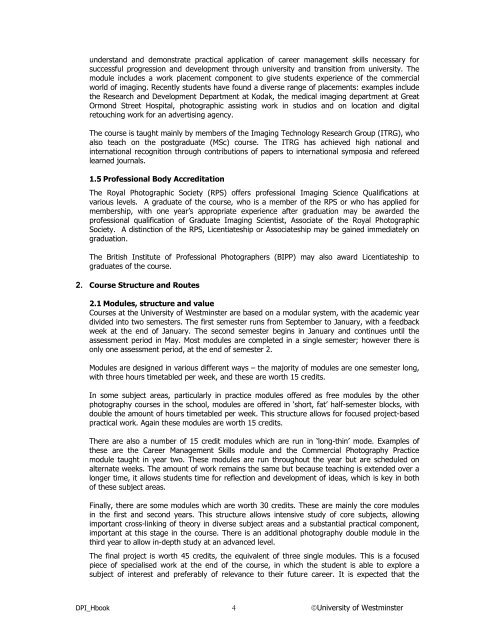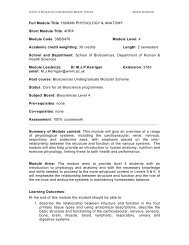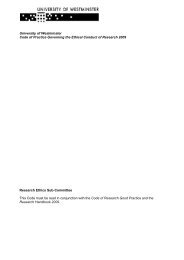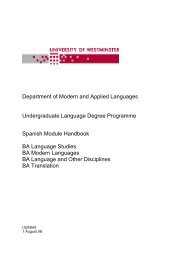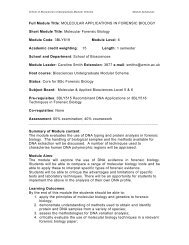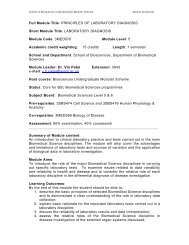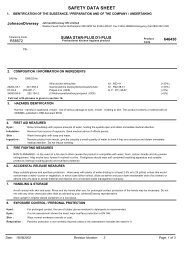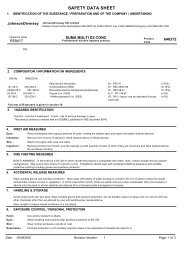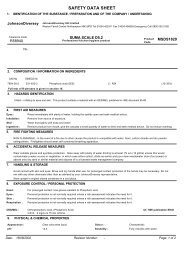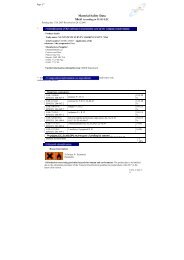CONTENTS 1. Introduction 1.1 Course Outline 1 1.2 Introduction ...
CONTENTS 1. Introduction 1.1 Course Outline 1 1.2 Introduction ...
CONTENTS 1. Introduction 1.1 Course Outline 1 1.2 Introduction ...
Create successful ePaper yourself
Turn your PDF publications into a flip-book with our unique Google optimized e-Paper software.
understand and demonstrate practical application of career management skills necessary for<br />
successful progression and development through university and transition from university. The<br />
module includes a work placement component to give students experience of the commercial<br />
world of imaging. Recently students have found a diverse range of placements: examples include<br />
the Research and Development Department at Kodak, the medical imaging department at Great<br />
Ormond Street Hospital, photographic assisting work in studios and on location and digital<br />
retouching work for an advertising agency.<br />
The course is taught mainly by members of the Imaging Technology Research Group (ITRG), who<br />
also teach on the postgraduate (MSc) course. The ITRG has achieved high national and<br />
international recognition through contributions of papers to international symposia and refereed<br />
learned journals.<br />
<strong>1.</strong>5 Professional Body Accreditation<br />
The Royal Photographic Society (RPS) offers professional Imaging Science Qualifications at<br />
various levels. A graduate of the course, who is a member of the RPS or who has applied for<br />
membership, with one year’s appropriate experience after graduation may be awarded the<br />
professional qualification of Graduate Imaging Scientist, Associate of the Royal Photographic<br />
Society. A distinction of the RPS, Licentiateship or Associateship may be gained immediately on<br />
graduation.<br />
The British Institute of Professional Photographers (BIPP) may also award Licentiateship to<br />
graduates of the course.<br />
2. <strong>Course</strong> Structure and Routes<br />
2.1 Modules, structure and value<br />
<strong>Course</strong>s at the University of Westminster are based on a modular system, with the academic year<br />
divided into two semesters. The first semester runs from September to January, with a feedback<br />
week at the end of January. The second semester begins in January and continues until the<br />
assessment period in May. Most modules are completed in a single semester; however there is<br />
only one assessment period, at the end of semester 2.<br />
Modules are designed in various different ways – the majority of modules are one semester long,<br />
with three hours timetabled per week, and these are worth 15 credits.<br />
In some subject areas, particularly in practice modules offered as free modules by the other<br />
photography courses in the school, modules are offered in ‘short, fat’ half-semester blocks, with<br />
double the amount of hours timetabled per week. This structure allows for focused project-based<br />
practical work. Again these modules are worth 15 credits.<br />
There are also a number of 15 credit modules which are run in ‘long-thin’ mode. Examples of<br />
these are the Career Management Skills module and the Commercial Photography Practice<br />
module taught in year two. These modules are run throughout the year but are scheduled on<br />
alternate weeks. The amount of work remains the same but because teaching is extended over a<br />
longer time, it allows students time for reflection and development of ideas, which is key in both<br />
of these subject areas.<br />
Finally, there are some modules which are worth 30 credits. These are mainly the core modules<br />
in the first and second years. This structure allows intensive study of core subjects, allowing<br />
important cross-linking of theory in diverse subject areas and a substantial practical component,<br />
important at this stage in the course. There is an additional photography double module in the<br />
third year to allow in-depth study at an advanced level.<br />
The final project is worth 45 credits, the equivalent of three single modules. This is a focused<br />
piece of specialised work at the end of the course, in which the student is able to explore a<br />
subject of interest and preferably of relevance to their future career. It is expected that the<br />
DPI_Hbook 4 ©University of Westminster


